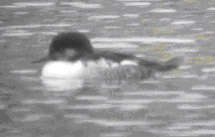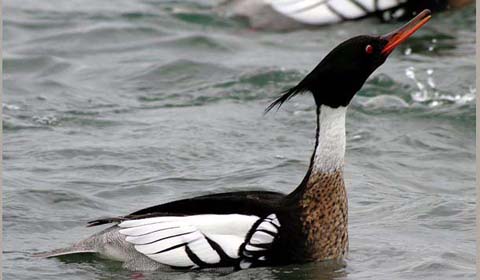Waterfowl Census Archive Reports
2007Top
Conditions
For the third consecutive year, the weather during the Waterfowl Count was excellent, providing near-perfect viewing conditions with exceptional visibility and little wind. The lake was calm, with all shoreline areas open, as were all bays and inner harbours. Temperatures ranged from +3°C to +7°C.
Remarks
This is the 61st 'Duck Count' for the Toronto Ornithological Club and 17th year that the entire Canadian shoreline of Lake Ontario has been covered. Ninety-eight participants spent 192 party-hours searching for waterfowl.
This year we recorded 258,603 waterfowl from 38 species (tied for second highest species total ever). This is lower than the average total for the previous 10 counts (273,822). A male Eurasian Wigeon found in Kingston was the first ever for the count since its 1947 inception. Record high numbers were also reported for an additional 12 (!) species:
Red-throated Loon (5 - previously 3 in 1991),
Common Loon (37 - previously 20 in 1998),
Horned Grebe (38 - previously 31 in 2000),
Red-necked Grebe (30 - previously 6 in 2004),
Double-crested Cormorant (84 - previously 79 in 2003),
Greater White-fronted Goose (2 - ties the 2 in 2003),
Northern Shoveler (133 - previously 75 in 2006),
American Wigeon (180 - previously 136 in 1983),
Ring-necked Duck (265 - previously 214 in 2002),
Hooded Merganser (292 - previously 221 in 2002),
Red-breasted Merganser (12,950! - previously 4942 in 2006) and
American Coot (413 - previously 276 in 2002).
Higher than usual numbers were reported for:
Tundra Swan (667 - second highest ever) and
Ruddy Duck (455 - second highest ever).
Lower than usual numbers were reported for:
Canada Goose (25,737 - lowest since 2001),
Mallard (7,071 - lowest since 1986),
Redhead (2,919 - lowest since 1999),
White-winged Scoter (2,123 - lowest since 2002) and
Common Goldeneye (19,003 - lowest since 1997).
Missed Species were Cackling Goose, Wood Duck, Barrow's Goldeneye and eiders. It is apparent from other counts being done in southern Ontario that the very mild temperatures preceeding this year's Lake Ontario Mid-Winter Waterfowl Inventory have resulted in higher Canada Goose and Mallard numbers staying inland around normally frozen smaller lakes and ponds, resulting in lower than normal numbers on the Lake Ontario survey. Similarly, Redhead numbers are down significantly on Lake Ontario, as it appears that the very mild temperatures in southern Ontario have left an unprecedented area of open water in areas further west (Lake Erie/Lake St. Clair/Detroit River/St. Clair River), where record numbers of Redhead are being found this winter. For instance, on the St. Clair National Wildlife Area Christmas Bird Count the 15,200 Redhead they counted on January 1, 2007, a mere six days before the present MWWI count, dwarfed their previous all-time high of 2,561. They set record highs for 11 species of waterfowl.
11 Bald Eagles were also reported (8 from Kingston, 2 from Hamilton, and 1 from Niagara).
An interesting hybrid waterfowl was a presumed Common Goldeneye x Hooded Merganser off Lakefront Promenade Park in Mississauga. An interesting exotic waterfowl find was a Barnacle Goose on a pond on Maple Grove Road near Vineland.

Presumed Common Goldeneye x Hooded Merganser hybrid. Lakefront Promenade Park, Mississauga. Photo: Don Perks
|
|
|
Toronto Area
In the Toronto area (Whitby Harbour to Bronte Harbour), 43,031 waterfowl from 31 species were reported. This is the lowest total since 1999 and slightly below the average total for the last 20 years (45,973).
Rarities included: 1 Red-throated Loon, 4 Common Loon, 26 Red-necked Grebe, 3 Double-crested Cormorant, 3 Tundra Swan, 2 Greater White-fronted Goose (first ever for the Toronto section of the count going back to 1947!), 90 Northern Shoveler, 1 Canvasback, 8 Ring-necked Duck, 5 Black Scoter, 19 Surf Scoter, 2 Ruddy Duck and 6 American Coot.
Niagara
Niagara had 1 Common Loon, 4 Horned Grebe, 48 Double-crested Cormorant and 6 Black Scoter.
Hamilton
Hamilton had 30 species including 1 Red-throated Loon, 3 Common Loon, 2 Pied-billed Grebe, 3 Green-winged Teal, 4 Northern Pintail, 43 Northern Shoveler, 84 Canvasback(!!), 36 Ring-necked Duck, 453 (!!) Ruddy Duck, and 97 American Coot. They also had almost 69,000 Long-tailed Duck.
Durham
Durham had 2 Horned Grebe and 1 Red-necked Grebe.
Port Hope
Port Hope had 1 Red-throated Loon and 3 Horned Grebe.
Presqu'ile
Presqu'ile had 2 Red-throated Loon, 2 Common Loon and 2 Harlequin Duck.
Quinte
Quinte had 101 American Coot.
Kingston
Kingston had 33 species including 27 Common Loon, 22 Horned Grebe, 661(!!) Tundra Swan, 4 Snow Goose, 15 Northern Pintail, 1 Eurasian Wigeon, 145 American Wigeon, 215 Ring-necked Duck, 2 Harlequin Duck, 163 Hooded Merganser and 205 American Coot.
Routes and Observers
KINGSTON (Ivy Lea to Prince Edward Point): Ron Weir plus 23 members of the Kingston Field Naturalists
QUINTE Area (Weller’s Bay to Point Petre): John Blaney
PRESQU'ILE (Barcovan Beach to Wicklow): Doug McRae
PORT HOPE (Wicklow to Wesleyville): Roger Frost, Elizabeth Kellogg, Clive Goodwin, Lori Wensley, Margaret Bain, Bob Short (Willow Beach Field Naturalists)
DURHAM (Wesleyville to Whitby): Rayfield Pye, Dennis Barry, Margaret Carney, Brian Henshaw, Tyler Hoar (Durham Region Naturalists)
TORONTO (Whitby to Oakville): Toronto Ornithological Club
Route 1 (Whitby to Rouge R.): Rob Nisbet, Ross Harris
Route 2 (Rouge R. to Coatsworth Cut): Roy B.H. Smith, Winnie Poon
Route 3 (Eastern Headland to Cherry St.): John Carley, Carl Hills, Jean Iron, William Hewitt
Route 4 (Toronto Islands): Glenn Coady, Don Barnett, Audrey Nowicki, Alison Paul
Route 5 (Parliament St. to Humber R.): Patrick Stepien-Scanlon, Bob Yukich
Route 6 (Humber R. to Watersedge Park): Don Perks, John Lamey
Route 7 (Watersedge Park to Bronte): Mark Cranford, Bill Siverns, Brian Sheppard, Jim Watt, Donna Sheppard, Carol Wardle, Mike Boyd, Rachel Li, David Li, Alan Telfer, Francis Roberts, Bill Karner, John Karner, Joyce LeChasseur, Gavin Edmonstone, Chris Duffy
HAMILTON (Bronte to 50 Point + Hamilton Bay): George Naylor, David Brewer, Tom Crooks, Rob Dobos, Dave Don, Cheryl Edgecombe, Denys Gardiner, Kyna Intini, Kevin McLaughlin, Bill Smith, Mike Street, Rob Waldhuber, Eva Sorer (Hamilton Naturalists Club)
NIAGARA (50 Point to Niagara-on-the-Lake): John Black, Brian Ahara, Blayne Farnan, Jean Farnan, Marcie Jacklin, Kayo Roy, Drew Campbell, Brad Clements, Trevor Cornfield, Brian Joule, Tim Seburn, Carol O’Shea, Maggie Smiley, John Stevens, Katharine Stoltz (Peninsula Field Naturalists)
Thanks to all the clubs and individuals who participated. Next year's count will take place on Jan. 6, 2008.
Compiler: Glenn Coady
2004Top
The 2004 Mid-Winter Waterfowl Inventory took place on January 11, under fair to poor weather conditions - a steady snowfall for most of the day, along with strong westerly winds (40-60 km/hr), which resulted in difficult viewing conditions for much of the lake. Some of the eastern areas also experienced slippery roads and had difficulty completing their entire routes. Most bays, channels, and inner harbours were completely frozen, so the only waterfowl found were on the open lake. Temperatures ranged from -10 to -5 ºC. This was the 58th count for the Toronto Ornithological Club, and the 14th year that the entire Canadian shoreline of Lake Ontario has been covered.
This year we counted 224,203 waterfowl from 36 species. This is the lowest total since 1998, and is undoubtedly due to the weather conditions. A highlight was the Blue-winged Teal in Hamilton, only the third in the history of the inventory.
|
|
|
Toronto Area
In the Toronto area (Whitby Harbour to Bronte Harbour) 60,324 waterfowl of 28 species were reported. This is our fifth highest total, but lowest since 1999; species with the highest counts were the usual Canada Goose, Greater Scaup, Mallard, Long-tailed Duck, Common Goldeneye, Redhead, Bufflehead, and Gadwall (listed in decreasing order of abundance). Within this region, record highs were set for only Trumpeter Swan (19), Mute Swan (277), and Mallard (10,497). Rarities included 1 Common Loon, 2 Red-necked Grebe, 3 Snow Goose, 1 Wood Duck, 1 Green-winged Teal, 4 Northern Pintail, 4 Northern Shoveler, 6 Canvasback, 2 Ring-necked Duck, 1 King Eider, 1 Surf Scoter, and 4 American Coot.
Niagara
Niagara highlights included 1 Horned Grebe, 23 Double-crested Cormorant, 1 King Eider, and 3 American Coot.
Hamilton
Hamilton had 34 species including 1 Common Loon, 2 Pied-billed Grebe, 2 Red-necked Grebe, 24 Double-crested Cormorant, 3 Tundra Swan, 2 Snow Goose, 2 Wood Duck, 24 Green-winged Teal, the only Blue-winged Teal (for the second year in a row), 8 Northern Shoveler, 94 Canvasback, 35 Ring-necked Duck, 4 King Eider, 1 Black Scoter, 42 Surf Scoter, 97 Ruddy Duck, 19 American Coot, and 1 Bald Eagle.
Port Hope
Port Hope had 1 Double-crested Cormorant; Presqu'ile featured 2 Tundra Swan and 109 Mute Swan. Quinte's highlight was another Bald Eagle.
Kingston
Kingston had 31 species including the only Red-throated Loon, 6 Common Loon, 1 Pied-billed Grebe, 2 Horned Grebe, 2 Red-necked Grebe, 17 Double-crested Cormorant, 489 Tundra Swan, 4 Green-winged teal, 2 Canvasback, 25 Ring-necked Duck, 2 Black Scoter, 5 Surf Scoter, 29 American Coot, and 24 Bald Eagle.
Thanks to all the clubs and individuals who participated. Next year's count will take place on Jan. 9, 2005.
